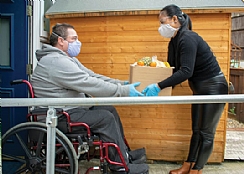The maximum sampling error for 95% accuracy is +/-4.6%
The survey’s populations include:
- 64% with physical and mobility disabilities,
- 10% with visual disabilities and blind,
- 10% with hearing disabilities and deaf,
- 7% with intellectual and cognitive disabilities,
- 12% with mental disabilities,
- 11% of family members of people with disabilities.
- 54% of respondents are men, 46% are women.
Conclusions
In Israel in the year 2020, there are about one million and a half people with disabilities, from the polls we learn that many of their crucial concerns are not being taken care during the corona crisis.
About 50% do not know at all who is responsible and who will take care of their needs.
The survey raises the most intense and significant needs of people with disabilities during the corona crisis. These times are challenging for us all, the elderly is mostly taken care of with various local and national formals governments initiatives.
The survey shows clearly the major concerns of People with difficult disabilities that are alone at home and at high risk that must avoid going out from their home.
They fear and have difficulty in picking up medicine or food deliveries that are left for them outside the door on the floor, or find it challenging to clean up their house.
The medical treatment of people with disabilities during the Corona crisis requires special attention – from the ways to communicate with a person who is hearing impair when your mouth is covered by a mask? to the unique treatments they need specifically to their personal situation, Their need to have their caregiver or companion by their side while being hospitalized. One can see the lack of readiness of the emergency services when it comes to people with disabilities and lack of information available about solutions and the removal of fears they are coping with these days.
Following are the findings of the survey relating to the needs of people with disabilities:
Housing situation:
17% live alone
20% live in an inaccessible residential building without an elevator
Help at Home:
14% are without help at all
23% are assisted by a caregiver
59% are assisted by family members
6% have a part time housekeeper.
External help
The basic needs that are necessary for people with disabilities:
- 32% of participants in the survey need help with getting medicine and medical equipment,
- 24% of participants in the survey need help with buying food,
- 23% of participants in the survey need help with cleaning their house.
- 7% are interested in getting a phone call from some one to talk with/
- 12% raise various needs such as receiving help with the children, help with repair at home, help in learning how to use the computer.
What are people with disabilities most concerned about:
- 40% fear from loneliness,
- 29% fear that they will not receive food,
- 38% fear that they will not receive medicine,
- 33% fear that they will not receive medical equipment,
- 55% fear that they will not receive medical treatments that they need,
- 64% fear of hospitalization without their caregiver (31% expressed high level of fear on this issue),
- 59% fear of isolation/quarantine without an escort/caregiver,
- 50% fear from lack of maintenance treatments (physical therapy),
- 34% fear from lack of knowledge of medical staff on how to communicate with them,
- 42% fear from lack of professional knowledge to treat them as a person with disabilities,
- 7% afraid of what will happen to their guide dog,
- 16% worry how the staff (medical, police etc.) will be able to communicate with them while wearing a mask,
- 21% are concerned about how they will have access to news, information and accessible updates,
- 31% are concerned from how they will be able to spend the time while at home.
Who is taking care of you in emergency?
- 50% do not know who is in officially in charge of taking care of them during times of emergency,
- 23% thought that the Welfare Department in their municipality is in charge of taking care of them in times of emergency,
- 22% thought those in charge are from the Social Security Offices,
- 9% thought the Ministry of Defense will take care of them,
- 6% thought it will be volunteer associations.
What are the issues people with disabilities are most concerned about during the time when they are prohibited from leaving their home?
- Loneliness for extended period,
- The ability to survive mentally without going outside
- Lack of physical “sporty” mobility and inability to get outside
- Access to the doctors and not being able to continue their treatment routine
- Repair and maintenance of medical equipment such as – what happens if the auditory implant or wheelchair needs repair?
- Return to employment as a person with disability
- Economic situation
- Maintenance of the customized accessible vehicle if it doesn’t start
- Improving food deliveries from the Supermarket enabling people with disability to receive priority in deliveries over others
What the channels by which information is received?
Approximately 82% are updated on information from the Internet and 76% from TV, 28% from the radio, 20% from emails.
What are the needs for accessible formats of information?
13% Want your subtitles, 2% in language simplification, 16% accessible websites, 10% enlarged fonts, 10% simple language, 3% sign Language
Ideas for improving situation for people with disabilities during these times:
- Making the official press conferences accessible with a sign language interpreter by his side and with closed captions.
- Assistance with shopping.
- Enabling unlimited sign language translations real time online.
- A campaign to map/locate lonely unknown people with disabilities who need help
- Help over the phone.
- Enabling blood and urine testing at home
- Advertising the services that the municipalities offer to assist people with disabilities
- There is a need to find a solution that will enable deliveries of medicine and medical equipment so be delivered in to the house and not just be brought to the floor door-step (that is not helpful)
What technologies do people with disabilities use?
26% textual information – SMS, WhatsApp, 12% software with captioning 10% accessible applications, 7% accessible Web sites for people with visual disabilities, 4% accessible Web sites for people with disabilities in their hands, 8% hearing aids.
Summary
This survey represents and speaks for itself. All the topics presented in this survey must be dealt with in order to assist people with disabilities during this crisis







